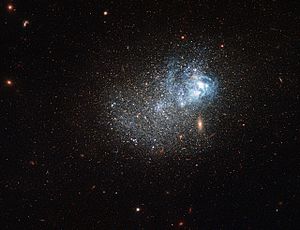I Zw 36 facts for kids
Quick facts for kids I Zw 36 |
|
|---|---|

I Zw 36, by Hubble Telescope
|
|
| Observation data (J2000 epoch) | |
| Right ascension | 12h 26m 16.02s |
| Declination | ±48° 29′ 36.6″ |
| Redshift | 0.000941 |
| Notable features | Blue compact galaxy also known as Markarian 209, with not so many stars |
| Other designations | |
| Markarian 209, PG 1223+488, UGCA 281, LEDA 40665, TC 211, Haro 29, Im 98 | |
| See also: Galaxy, List of galaxies | |
I Zwicky 36, often called I Zw 36, is a special type of dwarf galaxy. It's known as a "blue compact dwarf" galaxy. This means it's smaller than many other galaxies. It also has a lot of bright, young stars. These stars are very new, some being less than three million years old.
Contents
Studying I Zw 36: What We've Learned
Scientists use powerful telescopes to learn about distant galaxies like I Zw 36. One of the best tools for this is the Hubble Space Telescope. It orbits Earth and takes amazing pictures of space.
How Hubble Helps Us See
The Hubble Space Telescope has different cameras and tools. These tools can see light that our eyes can't. For example, they can see light in the ultraviolet (UV) and infrared (IR) parts of the spectrum.
- Faint Object Camera (FOC): This camera took pictures in near-UV light. It helped scientists find very hot and big stars in I Zw 36.
- Near Infrared Camera and Multi-Object Spectrometer (NICMOS): This tool looked at the galaxy in infrared light. It helped find cooler, smaller, and medium-sized stars.
What the Stars Tell Us
By studying different types of stars, scientists can learn about a galaxy's history.
- The FOC showed that I Zw 36 has many hot, massive stars. These stars don't live very long.
- The NICMOS data showed a mix of stars, including older ones.
- Scientists found signs that I Zw 36 was forming stars even before it became a "blue compact dwarf" galaxy.
- Some stars, like "luminous asymptotic giant branch" stars, are several million years old.
- Other stars, called "red giant" stars, are even older, possibly 1 to 2 billion years old. This tells us that I Zw 36 has been forming stars for a very long time.
See also
 In Spanish: I Zw 36 para niños
In Spanish: I Zw 36 para niños

